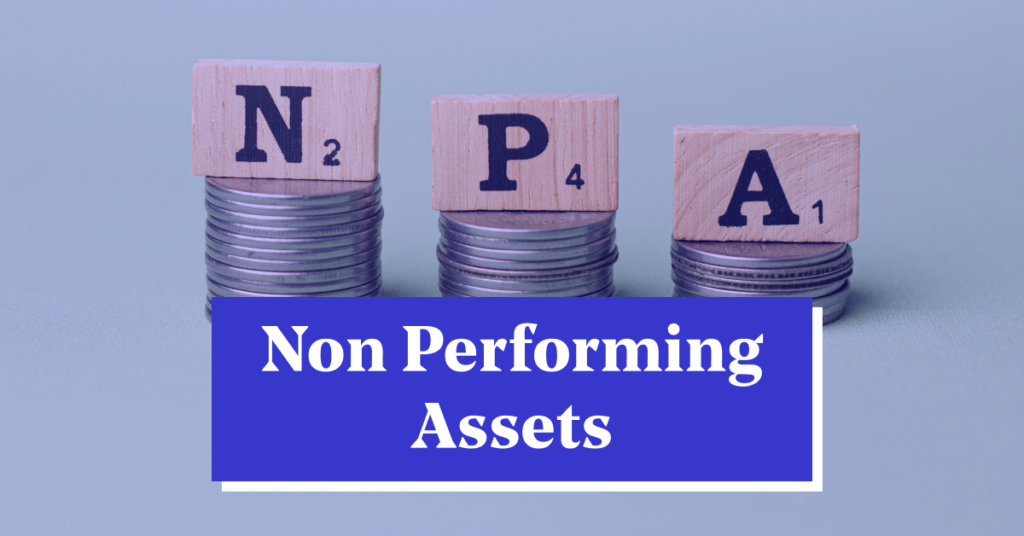NPA expands to non-performing assets (NPA). Reserve Bank of India defines Non Performing Assets in India as any advance or loan that is overdue for more than 90 days.
“An asset becomes non-performing when it ceases to generate income for the bank,” said RBI in a circular form 2007.
To be more attuned to international practises, RBI implemented the 90 days overdue norm for identifying NPAs has been made applicable from the year ended March 31, 2004. Depending on how long the assets have been an NPA, there are different types of non-performing assets as well.

What Is a Nonperforming Asset (NPA)?
A nonperforming asset (NPA) refers to a classification for loans or advances that are in default or in arrears. A loan is in arrears when principal or interest payments are late or missed. A loan is in default when the lender considers the loan agreement to be broken and the debtor is unable to meet his obligations.
Sub-Classifications for Non-Performing Assets (NPAs)
1. Standard Assets- They are NPAs that have been past due for anywhere from 90 days to 12 months, with a normal risk level.
2. Sub-Standard Assets- They are NPAs that have been past due for more than 12 months. They have a significantly higher risk level, combined with a borrower that has less than ideal credit. Banks usually assign a haircut (reduction in market value) to such NPAs because they are less certain that the borrower will eventually repay the full amount.
3. Doubtful Debts- Non-performing assets in the doubtful debts category have been past due for at least 18 months. Banks generally have serious doubts that the borrower will ever repay the full loan. This class of NPA seriously affects the bank’s own risk profile.
4. Loss Assets- These are non-performing assets with an extended period of non-payment. With this class, banks are forced to accept that the loan will never be repaid, and must record a loss on their balance sheet. The entire amount of the loan must be written off completely.
How Nonperforming Assets (NPA) Work
Nonperforming assets are listed on the balance sheet of a bank or other financial institution. After a prolonged period of non-payment, the lender will force the borrower to liquidate any assets that were pledged as part of the debt agreement. If no assets were pledged, the lender might write-off the asset as a bad debt and then sell it at a discount to a collection agency.In most cases, debt is classified as nonperforming when loan payments have not been made for a period of 90 days. While 90 days is the standard, the amount of elapsed time may be shorter or longer depending on the terms and conditions of each individual loan. A loan can be classified as a nonperforming asset at any point during the term of the loan or at its maturity.
For example, assume a company with a $10 million loan with interest-only payments of $50,000 per month fails to make a payment for three consecutive months. The lender may be required to categorize the loan as nonperforming to meet regulatory requirements. Alternatively, a loan can also be categorized as nonperforming if a company makes all interest payments but cannot repay the principal at maturity.Carrying nonperforming assets, also referred to as nonperforming loans, on the balance sheet places significant burden on the lender. The nonpayment of interest or principal reduces the lender’s cash flow, which can disrupt budgets and decrease earnings. Loan loss provisions, which are set aside to cover potential losses, reduce the capital available to provide subsequent loans to other borrowers. Once the actual losses from defaulted loans are determined, they are written off against earnings. Carrying a significant amount of NPAs on the balance sheet over a period of time is an indicator to regulators that the financial fitness of the bank is at risk.
Types of Nonperforming Assets (NPA)
- Overdraft and cash credit (OD/CC) accounts left out-of-order for more than 90 days
- Agricultural advances whose interest or principal installment payments remain overdue for two crop/harvest seasons for short duration crops or overdue one crop season for long duration crops
- Expected payment on any other type of account is overdue for more than 90 days
FAQs
What is Non Performing Assets?
Non-Performing Assets (NPAs) are loans or advances made by banks or financial institutions that have ceased to generate income for the lender due to the borrower’s failure to repay the loan principal and interest for 90 days or longer.
How Do Banks Deal With NPA?
Banks deal with non-performing assets (NPAs) using various methods, including litigation recovery, loan restructuring, and selling NPAs to asset reconstruction businesses.
The Reserve Bank of India has also implemented procedures such as the Insolvency and Bankruptcy Code (IBC) to simplify the settlement of stressed assets.
What Happens to Non-Performing Assets?
When a loan account is categorized as an NPA, the bank or financial institution takes different steps to recover the funds; however, if the bank is unable to collect the funds, the NPA amount is written off as a loss, and the bank is required to put aside provisions to cover the loss.
Practice area's of B K Goyal & Co LLP
Income Tax Return Filing | Income Tax Appeal | Income Tax Notice | GST Registration | GST Return Filing | FSSAI Registration | Company Registration | Company Audit | Company Annual Compliance | Income Tax Audit | Nidhi Company Registration| LLP Registration | Accounting in India | NGO Registration | NGO Audit | ESG | BRSR | Private Security Agency | Udyam Registration | Trademark Registration | Copyright Registration | Patent Registration | Import Export Code | Forensic Accounting and Fraud Detection | Section 8 Company | Foreign Company | 80G and 12A Certificate | FCRA Registration |DGGI Cases | Scrutiny Cases | Income Escapement Cases | Search & Seizure | CIT Appeal | ITAT Appeal | Auditors | Internal Audit | Financial Audit | Process Audit | IEC Code | CA Certification | Income Tax Penalty Notice u/s 271(1)(c) | Income Tax Notice u/s 142(1) | Income Tax Notice u/s 144 |Income Tax Notice u/s 148 | Income Tax Demand Notice | Psara License | FCRA Online
Company Registration Services in major cities of India
Company Registration in Jaipur | Company Registration in Delhi | Company Registration in Pune | Company Registration in Hyderabad | Company Registration in Bangalore | Company Registration in Chennai | Company Registration in Kolkata | Company Registration in Mumbai | Company Registration in India | Company Registration in Gurgaon | Company Registration in Noida | Company Registration in lucknow
Complete CA Services
RERA Services
Most read resources
tnreginet |rajssp | jharsewa | picme | pmkisan | webland | bonafide certificate | rent agreement format | tax audit applicability | 7/12 online maharasthra | kerala psc registration | antyodaya saral portal | appointment letter format | 115bac | section 41 of income tax act | GST Search Taxpayer | 194h | section 185 of companies act 2013 | caro 2020 | Challan 280 | itr intimation password | internal audit applicability | preliminiary expenses | mAadhar | e shram card | 194r | ec tamilnadu | 194a of income tax act | 80ddb | aaple sarkar portal | epf activation | scrap business | brsr | section 135 of companies act 2013 | depreciation on computer | section 186 of companies act 2013 | 80ttb | section 115bab | section 115ba | section 148 of income tax act | 80dd | 44ae of Income tax act | west bengal land registration | 194o of income tax act | 270a of income tax act | 80ccc | traces portal | 92e of income tax act | 142(1) of Income Tax Act | 80c of Income Tax Act | Directorate general of GST Intelligence | form 16 | section 164 of companies act | section 194a | section 138 of companies act 2013 | section 133 of companies act 2013
Practice area's of B K Goyal & Co LLP
Income Tax Return Filing | Income Tax Appeal | Income Tax Notice | GST Registration | GST Return Filing | FSSAI Registration | Company Registration | Company Audit | Company Annual Compliance | Income Tax Audit | Nidhi Company Registration| LLP Registration | Accounting in India | NGO Registration | NGO Audit | ESG | BRSR | Private Security Agency | Udyam Registration | Trademark Registration | Copyright Registration | Patent Registration | Import Export Code | Forensic Accounting and Fraud Detection | Section 8 Company | Foreign Company | 80G and 12A Certificate | FCRA Registration |DGGI Cases | Scrutiny Cases | Income Escapement Cases | Search & Seizure | CIT Appeal | ITAT Appeal | Auditors | Internal Audit | Financial Audit | Process Audit | IEC Code | CA Certification | Income Tax Penalty Notice u/s 271(1)(c) | Income Tax Notice u/s 142(1) | Income Tax Notice u/s 144 |Income Tax Notice u/s 148 | Income Tax Demand Notice | Psara License | FCRA Online
Company Registration Services in major cities of India
Company Registration in Jaipur | Company Registration in Delhi | Company Registration in Pune | Company Registration in Hyderabad | Company Registration in Bangalore | Company Registration in Chennai | Company Registration in Kolkata | Company Registration in Mumbai | Company Registration in India | Company Registration in Gurgaon | Company Registration in Noida | Company Registration in lucknow
Complete CA Services
RERA Services
Most read resources
tnreginet |rajssp | jharsewa | picme | pmkisan | webland | bonafide certificate | rent agreement format | tax audit applicability | 7/12 online maharasthra | kerala psc registration | antyodaya saral portal | appointment letter format | 115bac | section 41 of income tax act | GST Search Taxpayer | 194h | section 185 of companies act 2013 | caro 2020 | Challan 280 | itr intimation password | internal audit applicability | preliminiary expenses | mAadhar | e shram card | 194r | ec tamilnadu | 194a of income tax act | 80ddb | aaple sarkar portal | epf activation | scrap business | brsr | section 135 of companies act 2013 | depreciation on computer | section 186 of companies act 2013 | 80ttb | section 115bab | section 115ba | section 148 of income tax act | 80dd | 44ae of Income tax act | west bengal land registration | 194o of income tax act | 270a of income tax act | 80ccc | traces portal | 92e of income tax act | 142(1) of Income Tax Act | 80c of Income Tax Act | Directorate general of GST Intelligence | form 16 | section 164 of companies act | section 194a | section 138 of companies act 2013 | section 133 of companies act 2013
